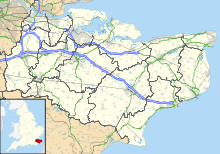Polhill Anglo-Saxon cemetery
| Established | 7th century CE |
|---|---|
| Location | Polhill, Kent |
| Coordinates | 51°18′34″N 0°09′30″E / 51.309423°N 0.158448°E |
| Type | Anglo-Saxon inhumation cemetery |
Polhill Anglo-Saxon cemetery is a place of burial that was used in the seventh and eighth centuries CE. It is located close to the hamlet of Polhill, near Sevenoaks in Kent, South-East England. Belonging to the Middle Anglo-Saxon period, it was part of the much wider tradition of burial in Early Anglo-Saxon England.
Polhill was an inhumation-only cemetery, with no evidence of cremation. An estimated 180 to 200 graves were placed there, containing between 200 and 220 individuals. The cemetery was on a false crest on the hill, having wide views of the surrounding landscape, and was roughly 1 hectare (2½ acres) in size. Many of the dead were interred with grave goods, which included personal ornaments, weapons, and domestic items, and some had tumuli erected above their graves.
The central area of the cemetery was sporadically excavated from 1839 to 1964 during the course of road building. Specific archaeological excavation of the west area of the site took place in 1967 under the directorship of Brian Philp, and continued in 1978. In 1984, Philp led the excavation of the east end of the cemetery in response to the expansion of the M25 motorway.
The cemetery is located on the lower slopes of Polhill, in the parish of Dunton Green near to Sevenoaks, Kent. Geologically, it sits upon a hard upper chalk layer, at the junction between the Darent Valley and North Downs scarp. The cemetery occupies a false crest on a steep hillside, commanding a view across the valley that is almost 3 kilometres wide, and also looks up the valley to the north and along the scarp to the south-west. Director of excavations Brian Philp thought this choice of location was "highly significant", allowing the "ancestors" to be buried in a "very dominant" position in the landscape.
The focal point of the local area is the village of Otford, located about 2 kilometres east of the cemetery. From the centre of Otford, the cemetery is visible, and Philp suggested that it was the most likely location of the Anglo-Saxon village where the people who used Polhill cemetery lived.
...
Wikipedia

